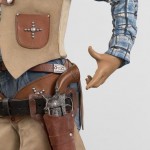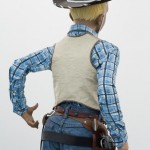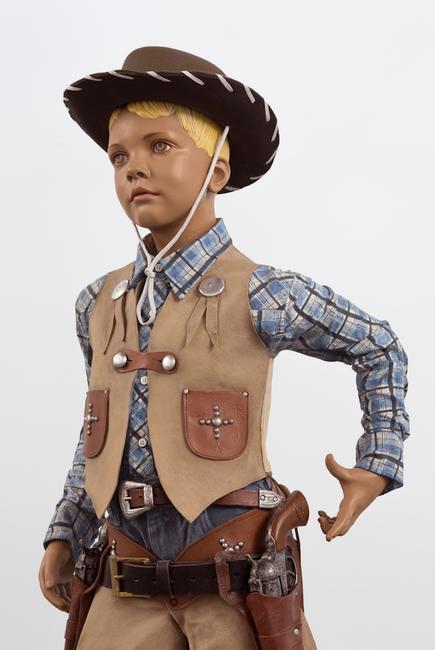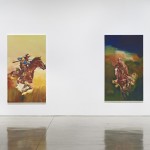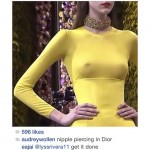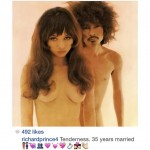Richard Prince is an appropriation artist, painter and photographer born 1949 in the Panama Canal Zone. Prince now lives and works in Upstate New York. Prince began copying other photographer’s work in 1975. His image, Untitled (Cowboy), a rephotographing of a photograph taken originally by Sam Abell and appropriated from a cigarette advertisement, was the first rephotograph to raise more than $1 million at auction when it was sold at Christie’s New York in 2005.
Untitled (Cowboy) / Cowboys

Prince has created an alternative twist to Abell’s work, his painting incorporating a bountiful perspective and outlook originally presented – this ‘wildness‘. From a reader, the difference between the sculpture as shown above juxtaposed with the paintings questions the truth of the artwork, what one was the original interpretation?
Taken from Marlboro cigarette advertisements of the Marlboro Man, they represent an idealized figure of American masculinity. The Marlboro Man was the iconic equivalent of later brands like Ralph Lauren, which used the polo pony image to identify and associate its brand.
“Every week. I’d see one and be like, Oh that’s mine, Thank you,”
Prince stated in an interview.
Prince’s Cowboys displayed men in boots and ten-gallon hats, with horses, lassos, spurs and all the fixings that make up the stereotypical image of a cowboy. They were set in the Western U.S., in arid landscapes with stone outcrops flanked by cacti and tumbleweeds, with backdrops of sunsets. The advertisements were staged with the utmost attention to detail.
It has been suggested that Prince’s works raise the question of what is real, what is a ‘real’ cowboy? and what makes it so? Prince’s photographs of these advertisements attempt to prompt one to decide how real are media images. The subjects of Prince’s rephotographs are the photos of others. He is photographing the works of other photographers, who in the case of the cowboys, had been hired by Marlboro to create images depicting cowboys. Prince described his process in a 2003 interview by Steve Lafreiniere in Artforum.
“I had limited technical skills regarding the camera. Actually I had no skills. I played the camera. I used a cheap commercial lab to blow up the pictures. I made editions of two. I never went into a darkroom.”
Starting in 1977, Prince photographed four photographs which previously appeared in the New York Times. This process of rephotographing continued into 1983, when his work Spiritual America featured Garry Gross’s photo of Brooke Shields at the age of ten, standing in a bathtub, as an allusion to precocious sexuality and to the Alfred Stieglitz photograph by the same name. His Jokes series (beginning 1986) concerns the sexual fantasies and sexual frustrations of middle-class America, using stand-up comedy and burlesque humor. This photo is now displayed in the new Renzo Piano-designed Whitney Museum of American Art.
Re-photography uses appropriation as its own focus: artists pull from the works of others and the worlds they depict to create their own work. Appropriation art became popular in the late 1970s. Other appropriation artists such as Sherrie Levine, Louise Lawler, Vikky Alexander, Cindy Sherman, Barbara Kruger and Mike Bidlo also became prominent in the East Village in the 1980s.
During the early period of his career, Prince worked in Time Magazine’s tear sheets department. At the end of each work day, he would be left with nothing but the torn out advertising images from the eight or so magazines owned by Time-Life. On the topic of found photographs, Prince said:
“Oceans without surfers, cowboys without Marlboros…Even though I’m aware of the classicism of the images. I seem to go after images that I don’t quite believe. And, I try to re-present them even more unbelievably.”
Prince had very little experience with photography, but he has said in interviews that all he needed was a subject, the medium would follow, whether it be paint and brush or camera and film. He compared his new method of searching out interesting advertisements to “beachcombing.” His first series during this time focused on models, living room furniture, watches, pens, and jewellery. Pop culture became the focus of his work. Prince described his experience of appropriation thus:
“At first it was pretty reckless. Plagiarising someone else’s photograph, making a new picture effortlessly. Making the exposure, looking through the lens and clicking, felt like an unwelling . . . a whole new history without the old one. It absolutely destroyed any associations I had experienced with putting things together. And of course the whole thing about the naturalness of the film’s ability to appropriate. I always thought it had a lot to do with having a chip on your shoulder.”
In 2014, Prince continued his appropriation theme with an exhibit of 38 portraits at the Gagosian gallery in New York City, entitled “New Portraits.” Each image was taken from his Instagram feed and included topless images of models, artists, and celebrities. Underneath the images, Prince provided comments like,
“Don’t du anything. Just B Urself © ®”
with the copyright and registered trademark symbols likely being references to his interests in authorship.
“Possible cogent responses to the show include naughty delight and sheer abhorrence”,
wrote art critic Peter Schjeldahl in The New Yorker.
“My own was something like a wish to be dead.”
As with previous appropriated Prince works, the Instagram prints draw attention to the intersection of art and copyright infringement; Prince has been challenged in courts but has so far won his cases. Some of the unwilling subjects of his art, notably members of SuicideGirls, have started selling their own derivative works based on Prince derivative works of their original works. This makes Prince’s work more conceptualised as people understand art is not there to be like but to prove a message that re-worked art can be categorised as art. In 2015, Prince would repeat his exhibit from Gagosian with a new exhibit for the Frieze Art Fair in NYC. However, Prince would end up making headlines due to selling the portraits for profit–at the fair, Prince sold enlargements of his Instagram feed and comments for $90,000.
How has Prince’s re-workings of his series ‘New Portraits‘ inspired me to use Tinder as a way of appropriating people into finding new ways of love?
In response to Prince, I think it would be an interesting idea to frame my own portraits within a tinder profile. During my development, I will ask my friends to screen-shot their Tinder profiles and display each image they use on their tinder profile. Capturing separate portraits could exempt the idea of how truthful they are behind their profile. I will also ask family and family friends who have been in longer relationships previous to social media and online-dating coming about, as well as their insight into how they met, how successful the relationship is and their opinion into social media being a tool of love making.



